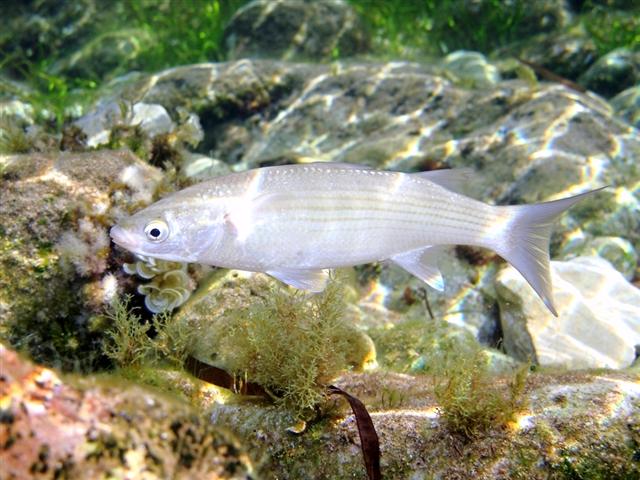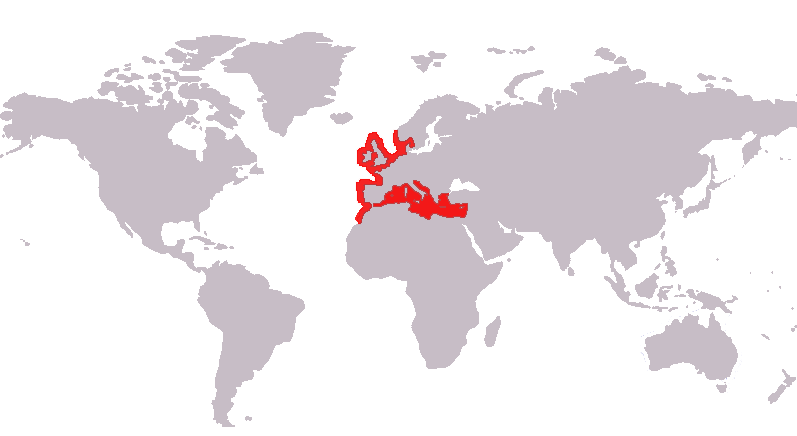Mullet

© Roberto Pillon [CC BY 3.0], via Wikimedia Commons
Scientific Name: Chelon labrosus, Liza ramada, Liza aurata
Also Known As: Thick lipped mullet. thin lipped mullet, golden grey mullet
MCRS: Chelon labrosus – 20cm within the legacy NWSFC District
Description
C. labrosus has a cylindrical elongate body with a broad head that is flattened on top and a large forked tail. They have relatively small mouths with thick lips. They are grey/blue on the back and silvery on the flanks and belly. They are found up to 70 cm in length.
L. ramada is similar in appearance to C. labrosus with a large flattened head but a narrower lip.
L. aurata is dark grey on the back that turns to silver on the belly. Maximum length is about 60 cm but they are commonly found around 30 cm. They have a golden spot over the gill covers.
Habitat and Distribution

By Etrusko25 (Own work) [CC BY-SA 3.0], via Wikimedia Commons
All three species are found around all coasts of Britain and Ireland especially in Southern Scotland and the English Channel. They are catadromous (migrates from freshwater to seawater to spawn) species and are usually found in brackish water around estuaries and harbours. Found inshore in schools, they migrate occasionally and tend to move northward in summer time. They are commonly found at 0-10 m depth and rarely deeper than that. Their distribution ranges from Scandinavia and Iceland down to Senegal in the Eastern Atlantic and throughout the Mediterranean Sea.
Life Cycle, Reproduction and Feeding
Adult grey mullet feed on benthic diatoms, algae, small invertebrates and detritus. They are commonly seen around harbours and jetties and feed on the bread thrown to them. They reduce feeding effort in the winter months.
Reproduction occurs further offshore during winter and spawning produces pelagic eggs in February-April. Fecundity differs slightly between species (see table). Juveniles move to coastal lagoons and estuaries easily adapting to freshwater in April-June. Age and size at sexual maturity can also differ between species, for all three species males tend to reach sexual maturity and reproduce for the first time before females (see table). Females reach a larger size than males.
The size at sexual maturity and fecundity of three mullet species:
| Thick Lipped
(Chelon labrosus) | Thin Lipped
(Liza ramada) | Golden grey
(Liza aurata) | |
| Size at maturity
(Male) | 280-320mm | 250-290mm | 250-280mm |
| Size at maturity
(female) | 280-320mm | 250-320mm | 250-280mm |
| Fecundity | Up to 750,000 eggs | Up to 700,00 eggs | Up to 500,000 eggs |
Additional Information
Mullet are a slow growing long lived species. When there is no MCRS, individuals can be fished before they reach sexual maturity and so do not have a chance to spawn.
In the NWIFCA District
Grey mullet are popular with anglers; they often school around inshore areas in estuaries and around jetties. However mullet can be spooked very easily and are quite difficult to catch making them a popular sport fish. Mullet can be fished commercially with a variety of inshore gears including trawls and static nets. Within the District mullet are usually caught using nets set close to shore. There is little information available on abundance of the mullet species’ around the UK due to lack of data; however evidence from the National Mullet Club (NMC) suggest that mullet stocks have declined in many areas around the British Isles in recent years. For more information visit the National Mullet Club.
Fisheries Management
Within the District there is a suite of netting Byelaws which vary for different areas. Read more about this here.
Where commercial trawling and netting occurs in Marine Protected Areas it undergoes an assessment to ensure the activity does not cause risk to conservation features. HRAs carried out for trawling and netting in the District’s European Marine Sites can be found here.